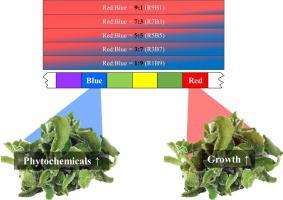Journal of Applied Research on Medicinal and Aromatic Plants ( IF 3.9 ) Pub Date : 2020-07-29 , DOI: 10.1016/j.jarmap.2020.100267 Young J. Kim , Hye M. Kim , Hyeon M. Kim , Hye R. Lee , Byoung R. Jeong , Hyeon-Jeong Lee , Hyun-Jin Kim , Seung J. Hwang

|
As a high value added crop, the ice plant (Mesembryanthemum crystallinum L.) as known to be effective in diabetes and is becoming widely used by consumers. This study aimed to improve the growth and phytochemical contents of the ice plant using combinations of red and blue light-emitting diodes (LEDs) in a closed-type plant production system. Seedlings of the ice plant were transplanted into a deep floating technique system with a recycling nutrient solution (EC 4.0 dS m-1, pH 6.5). The plants were cultured under a temperature 25 ± 1 ℃ and a relative humidity 60 ± 5%. The combinations of red and blue LEDs (R9B1, red:blue = 9:1; R7B3, red:blue = 7:3; R5B5, red:blue = 5:5; R3R7, red:blue = 3:7; and R1B9, red:blue = 1:9) were used at 150 ± 5 μmol·m-2·s-1 PPFD with a photoperiod of 14 h/10 h (light/dark) for 28 days. Growth of the ice plant presented significantly higher values under the R9B1 and R7B3 for high ratio of red LED treatments. The fresh and dry weights per plant of shoot were the lowest in the R1B9 at 4.49 g and 0.14 g, respectively. Total phenolic concentration, total flavonoid concentration, and antioxidant activity of the ice plant increased proportionally to the treated blue LED ratio. In addition, the concentration per dry weight of myo-inositol was the highest in the R1B9 at 310.83 mg g-1. While pinitol concentration of the ice plant showed no increasing tendency with blue LEDs, significantly higher values were obtained under the high blue ratios, such as R3B7 and R1B9 treatments. In conclusions, when considering the phytochemical contents per biomass of the ice plant consumed by actual consumers, it was the most effective applying red and blue LEDs in a closed-type plant production system at the 70-90% or 10-30%, respectively.
中文翻译:

在封闭型植物生产系统中,受红色和蓝色LED的各种混合比例的影响,冰厂(Mesembryanthemum crystallinum L.)的生长和植物化学物质
作为高附加值作物,制冰厂(Mesembryanthemum crystallinum L.)在糖尿病中有效,并已被消费者广泛使用。这项研究旨在通过在封闭型植物生产系统中结合使用红色和蓝色发光二极管(LED)来改善制冰厂的生长和植物化学含量。将制冰厂的幼苗移植到具有循环营养液(EC 4.0 dS m -1,pH 6.5)的深浮技术系统中。将植物在25±1℃的温度和60±5%的相对湿度下培养。红色和蓝色LED的组合(R9B1,红色:蓝色= 9:1; R7B3,红色:蓝色= 7:3; R5B5,红色:蓝色= 5:5; R3R7,红色:蓝色= 3:7;和R1B9 ,红色:蓝色= 1:9)在150±5μmol·m -2 ·s的条件下使用-1 PPFD,光周期为14 h / 10 h(亮/暗),持续28天。对于高比例的红色LED处理,在R9B1和R7B3下,制冰厂的生长呈现出明显更高的值。在R1B9中,每株新梢的鲜重和干重最低,分别为4.49 g和0.14 g。制冰厂的总酚浓度,总类黄酮浓度和抗氧化活性与处理的蓝色LED比例成比例地增加。此外,R1B9中每单位干重肌醇的浓度最高,为310.83 mg g -1。制冰厂的松果醇浓度没有显示出增加蓝色LED的趋势,但是在高蓝光比下(例如R3B7和R1B9处理)获得了明显更高的值。总而言之,当考虑实际消费者消耗的冰厂每生物量的植物化学含量时,在封闭型工厂生产系统中分别以70-90%或10-30%的比例使用红色和蓝色LED最有效。 。


























 京公网安备 11010802027423号
京公网安备 11010802027423号